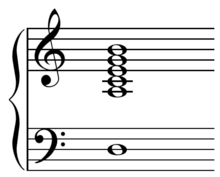Maiden Voyage (composition)
"Maiden Voyage" is a jazz composition by Herbie Hancock from his 1965 album Maiden Voyage. It features Hancock's quartet – trumpeter Freddie Hubbard, bassist Ron Carter and drummer Tony Williams – with additional saxophonist George Coleman. It is one of Hancock's best-known compositions and has become a jazz standard.[3]
The piece was used in a Fabergé commercial and was originally listed on the album's master tape as "TV Jingle" until Hancock's sister came up with the new name.[4] In the liner notes for the Maiden Voyage album, Hancock states that the composition was an attempt to capture "the splendor of a sea-going vessel on its maiden voyage".
Structure

A modal jazz piece, the composition follows a 32-bar AABA form with only two chords in each section:[7]
Ami7/D | | | | Cmi7/F | | | Ami7/D | | | | Cmi7/F | | | Bbmi7/Eb | | | | C#mi9 | | | Ami7/D | | | | Cmi7/F | | | [5]
The chord voicings used by Hancock make extensive use of perfect fourths. Jazz.com's Ted Gioia describes the harmonic progression used as, "four suspended chords," [8] Jerry Coker describes the progression as "only sus. 4 chords,"[9] while The Real Book lists the chords as four minor seventh chords with the bass note a fifth below the root[10] which matches Hancock's description of the opening chord (right).[5] The Real Book also spells the fourth chord (mm.22-24) as A♭-7/D♭,[10] while Owens spells it C♯mi13.[11] The pitches of C♯mi9 (ninth chord) are C♯ E G♯ B D♯ and the pitches of A♭-7/D♭ enharmonically, and C♯mi13 (thirteenth chord), are C♯ G♯ B D♯ F♯ (A♯).
Covers
- Hancock later reworked the track into the more electronically tinged "Maiden Voyage / P. Bop" on his 1988 album Perfect Machine.
- American rock band Toto covered the piece on their 2002 album Through the Looking Glass.
- American jam band Phish has been known to cover the piece in their live shows, and a recording of it appears on their live album Colorado '88.
- Robert Glasper performed a cover of "Maiden Voyage" interspersed into the Radiohead song "Everything In Its Right Place" on the album In My Element.
- Bobby Hutcherson performed a version with Hancock on his 1966 album Happenings.
- American rock/jazz band Blood, Sweat & Tears covered "Maiden Voyage" on their 1972 album New Blood.
- Joey Alexander performed a cover on his 2016 album "Countdown".
Notes
- ↑ Herder, Ronald (1987). 1000 Keyboard Ideas, p.75. ISBN 978-0-943748-48-1.
- ↑ Coker, Jerry (1997). Jerry Coker's complete method for improvisation: for all instruments, p.64. ISBN 978-0-7692-1856-4.
- ↑ Carr, Ian; Fairweather, Digby; Priestley, Brian (2004). The Rough Guide to Jazz. Rough Guides. p. 332. ISBN 1-84353-256-5.
- ↑ Rosenthal, David H. (1993). Hard Bop: Jazz and black music 1955–1965. Oxford University Press US. p. 68. ISBN 0-19-508556-6.
- 1 2 3 Kernfeld, Barry (1997). What to Listen for in Jazz, p.68. ISBN 978-0-300-07259-4.
- ↑ Kernfeld, Barry (1997). What to Listen For in Jazz, p.23. ISBN 9780300072594.
- ↑ Kernfeld, Barry Dean (1995). The Blackwell Guide to Recorded Jazz. Wiley-Blackwell. p. 388. ISBN 0-631-19552-1.
- ↑ Gioia, Ted (18 December 2007). "Herbie Hancock: Maiden Voyage". Jazz.com. Retrieved 30 August 2010.
- ↑ Coker, Jerry (1984). Jazz Keyboard for Pianists and Non-Pianists, p.46. ISBN 0-7692-3323-6.
- 1 2 The Real Book, Volume I. Hal Leonard corporation. 2004. p. 261. ISBN 0-634-06038-4.
- ↑ Owens, Thomas (1996). Bebop: The Music and Its Players, p.164. ISBN 9780195106510.
